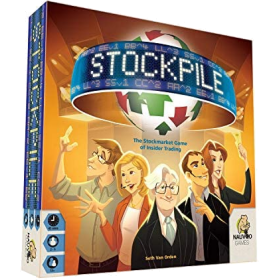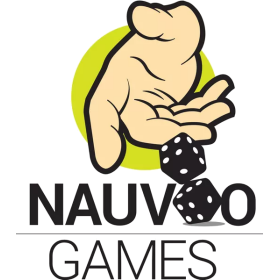Stockpile
 Stockpile es un juego de mesa económico que combina la estrategia tradicional de almacenamiento de acciones de comprar barato y vender caro con varios mecanismos adicionales para crear una experiencia dinámica, atractiva e interactiva.
Stockpile es un juego de mesa económico que combina la estrategia tradicional de almacenamiento de acciones de comprar barato y vender caro con varios mecanismos adicionales para crear una experiencia dinámica, atractiva e interactiva.
En Stockpile, los jugadores actúan como inversionistas del mercado de valores a finales del siglo XX con la esperanza de hacerse ricos, y el inversionista con más dinero al final del juego es el ganador. Stockpile se centra en la idea de que nadie sabe todo sobre el mercado de valores, pero todos saben algo. En el juego, esta filosofía se manifiesta de dos maneras: información privilegiada y reservas.
Primero, los jugadores reciben información privilegiada en cada ronda. Esta información dicta cómo cambiará el valor de una acción al final de la ronda. Al saber de forma privada si una acción va a subir o bajar, cada jugador tiene la oportunidad de actuar por delante del mercado comprando o vendiendo en el momento adecuado.
En segundo lugar, los jugadores compran sus acciones haciendo ofertas en montones de cartas llamados reservas. Estas reservas contendrán una mezcla de cartas boca arriba y boca abajo colocadas por otros jugadores en el juego. De esta forma, nadie conocerá todas las cartas de las reservas. No todas las cartas son buenas tampoco. Las tarifas comerciales pueden envenenar las pilas al hacer que los jugadores paguen más de lo que pujan. Al poner acciones y otras cartas en subasta, Stockpile cataliza la interacción del jugador, especialmente cuando las ganancias potenciales de la información privilegiada están en juego.
Ambos mecanismos se combinan con algunos elementos del mercado de valores para que los jugadores consideren múltiples factores al vender una acción. ¿Mantienes una acción con la esperanza de obtener una lucrativa división de acciones o la vendes ahora para evitar la posible quiebra de la empresa? ¿Puedes conservar tus acciones hasta el final del juego para convertirte en el accionista mayoritario, o necesitas la liquidez del efectivo ahora para futuras ofertas? ¿Lo arriesgas todo invirtiendo fuertemente en una empresa o mitigas tu riesgo diversificando tu cartera?
Al final, todo el mundo sabe algo sobre el mercado de valores, por lo que todo se reduce a la ejecución de la estrategia. ¿Serás capaz de interpretar los movimientos del mercado de valores con certeza? ¿O tus inversiones se hundirán debido a malas predicciones?
Número de jugadores: 2 - 5
Duración de la partida: 39 mn
Complejidad: 2 / 5
Juega Stockpile y 1184 otros juegos en línea.
No es necesaria ninguna descarga - juega directamente desde tu navegador.
Con tus amigos y con miles de jugadores del mundo entero.
Gratis.

Juega Stockpile y 1184 otros juegos en línea.
No es necesaria ninguna descarga - juega directamente desde tu navegador.
Con tus amigos y con miles de jugadores del mundo entero.
Gratis.

Sumario de reglas
Overview
Stockpile is a fast-paced economic game of corporate investments, insider trading, and market manipulation. Each player acts as a private investor with the goal of amassing the greatest net worth. The player with the most money at the end of the game wins.
Playing The Game
Stockpile is played over 5-7 rounds, depending on the number of players. Each round consists of six phases:
- Information Phase
- Supply Phase
- Demand Phase
- Action Phase
- Selling Phase
- Movement Phase
During each phase, play begins with the player with the First Player Token and continues clockwise.
Information Phase
During the Information Phase, each player receives insider information in the form of a Company Card and a Forecast Card. Each player should look at their Company and Forecast Cards and keep them hidden from other players. The two cards are paired together to indicate a future change to a particular company's stock value. The actual change of the stock value takes place at the end of the round during the Movement Phase.
One pair of Company and Forecast Cards is public information (No public pairs exist in a 2P game). Both pairs of cards (the insider information and public information) should be used to make decisions during the Demand Phase and Selling Phase.
All 6 company's stock values will be impacted every round by a Forecast Card.
In the base game, the 6 Forecast Cards are all different. The Forecast Cards include: -3, -2, $$, +1, +2, +4. These values are also listed on the Player Board.
Supply Phase
One card is placed from the Market Deck face-up onto each Stockpile. These cards could be shares of company stock, trading fees, or action cards.
Each player is dealt two cards from the Market Deck.
In turn order, each player places one card face-up and one card facedown on the Stockpile(s) of their choice.
Demand Phase
Players take turns bidding on Stockpiles until each Stockpile has only one Bidding Meeple on it.
Players pay their bids, collect all cards, and pay any trading fees. Trading fees range between $1,000 - $3,000.
Stock cards are kept hidden in a player's stock portfolio.
Action Phase
In turn order, players use all Action Cards acquired during the Demand Phase. Action Cards may move a stock's value by +2 or -2.
Selling Phase
In turn order, players may sell any number of stocks that they own and receive money from the supply equal to their current value. When selling a split stock, you may choose to sell one or both of its shares.
Movement Phase
All pairs of Company Cards and Forecast Cards are revealed and the stock values move accordingly, taking into account stock splits and bankruptcy.
- Stock Split - If a stock’s value ever increases to more than 10, the stock splits. A stock split effectively doubles your existing shares for that stock. When a stock splits, all players who have stock of that type in their portfolio will reveal it and move it to their Split Portfolio face-down. If the increase causes the stock’s value to land exactly on the Stock Split space, then the value of the stock returns to 6. If the stock’s increase would move the value further than the Stock Split space, reset the value of the stock to 6 and continue to increase the stock’s value.
- IMPORTANT: Any new stock obtained after the stock split goes in a player’s regular Stock Portfolio, not the Split Portfolio. If a player already owns a stock in his Split Portfolio and that stock splits again later in the game, then that player receives $10,000 in Currency Cards for each Stock Card of that type in their Split Portfolio. The stock then remains in the Split Portfolio.
- Bankruptcy - If a stock’s value ever moves below 1 on a turn, it immediately goes bankrupt. All players discard all stock of that kind that they own, including any stocks in their Split Portfolio. Return the stock’s price to the starting value of 5.
The Forecast Cards with $$ indicates a $2,000 dividend for each share that a player owns and elects to show.
Round End
Advance the Round Marker and pass the First Player Token clockwise to the next player.
Game End
At the end of the game, players will reveal all of the stock cards in their portfolio and perform the following steps:
- Determine majority shareholders. A majority shareholder is the player with the most stock in any company. The majority shareholders of each company receive a bonus of $10,000. If there is a tie, all tied players receive $5,000. Reminder: Shares in player’s Split Portfolios count as double when determining majority shareholders.
- Sell all stock at final values. Each player then sells their shares to the bank at a price equal to the final value of the stock. Reminder: Any shares in players’ Split Portfolios count as double.
- Total each player’s currency. Add up each player’s money, including any Currency Cards on hand.
The player(s) with the most money wins.
2P Variant
It's suggested to play Stockpile at least once with more than two players before trying the 2-Player Variant. The 2-player variant plays similar to a 4-player game. However, there a few changes to the round’s phases. These can be round in the rules here: https://boardgamearena.com/gamepanel?game=stockpile

